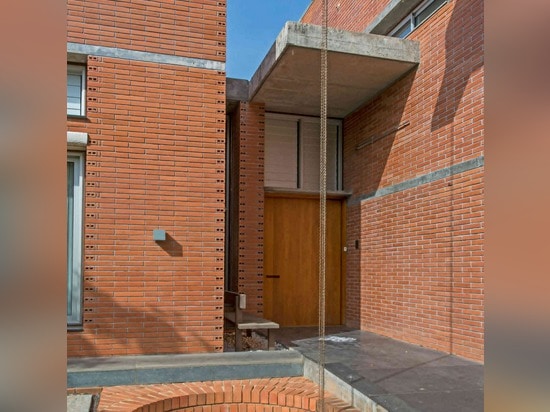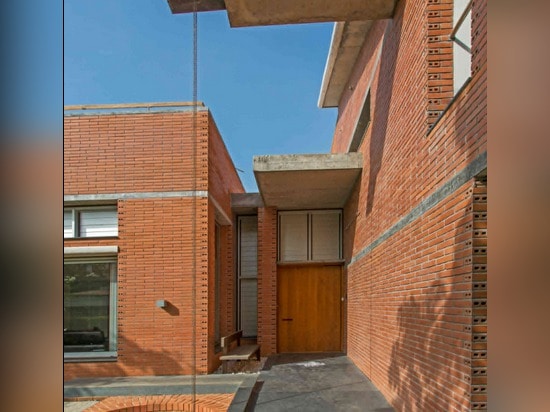
#RESIDENTIAL ARCHITECTURE PROJECTS
Srikanth and Gita House
Srikanth and Gita were looking for a traditional South-Indian ‘agraharam’ house, well ventilated with courtyards. This was the design cue that was taken forward in Srikanth House.
The Background:
A traditional ‘agraharam’ house is a long rectangular temple street house stacked around the four streets that bound the temple. These street-fronted houses have a deep social and cultural value in their organisation of space - being narrow and linear, the hierarchy of rooms range from public areas up front to the more private family spaces deeper in. Climatically though these houses are disadvantaged since in hot-humid climate zones, there is a need for well cross ventilated rooms with ample openings all around, which these homes do not have. These homes often share walls and are forced to depend on a through wind passage running the length of the house interspersed with open-to-sky courts for ventilation and light with rooms alongside. This, climatically speaking, is the most important feature of the house and is hence traditionally called the ‘vamsamoolam’, or the lifeline of the house. This is however insufficient most times as the ambient wind velocities are not enough to generate enough air flow within the homes to provide sensible evaporative cooling to its residents.
Traditionally, in coastal Tamilnadu, a ventilating device called kattrupandal, a wind pavilion was prevalent in the early part of the 20th century. The pavilion has an inclined roof that opens up to the incident wind direction at a greater height and funnels the breeze into the house, often located over courtyards. While most ventilation devices in Southern India are passive, this is one of the few that try to provide an 'active' ventilation device.
The design of Srikanth and Gita's house has sought to integrate two principles - to have a soul of a traditional ‘agraharam’ house but to facilitate better ventilation and to increase ambient wind velocities within the house for a cooler indoor environment.
The site for the house is narrow fronted, facing north. It was important for the design to harness the ambient southern breeze. The plan, following an ‘agraharam’ thought process, is linear with rooms grouped on either sides of a passage that runs the full length of the house forming a strong North-South axis. The rooms are arranged in a traditional manner, public domain up front and more private spaces deeper within the house. The main access to the house is along a strongly defined black, leather-finished granite pathway. One enters the house through a solid teakwood pivoted door which is the leeward end of the wind tunnel. A strong gust of breeze often greets one at the door - the south breeze funnelling through the wind passage, which we call the katrupadai, along the length of the house. The living-room, family-room, family lounge and the dining-room, in that order are located along the ‘katrupadai’. Each of these rooms overlooks courtyards which feed off the wind passage. The walls on the courtyard from each of these rooms slide and fold away completely, to open up this rooms into one large space, that is part covered and part open. Three bedrooms are located further down the katrupadai - Two bedrooms at the ground level and one bedroom at the upper level. All the bedrooms open to the South and North to facilitate cross ventilation. There is a guest-bedroom suite that comes at the front of the house, close to the entrance. It sits on a three car garage and is accessed by an open to sky stair court. A naturally ventilated gymnasium with a library suspended within is located at the rear of the house. A weave of cement boards provides a ventilated skin that provides privacy and also cuts off solar glare.
The ‘katrupadai’ is a 1.65 m wide long rectangle but works differently in section. At its mouth, in the rear of the house, it opens up to the South breeze rising to a height of 7.20 m to harness greater velocities. The roof then slopes downward coming down to a third of its height like a funnel with no openings in the sides. This causes the large volume of air that builds up on the southern face to funnel down into the wind passage with an increased velocity. Then the roof begins to rise in height, as a release of the pressure created by the wind. As a result the rooms along the sides of the ‘katrupadai’ experiences constant air flow at better velocities. (This has been tested by hand held anemometers and the results indicate that the wind velocities with the house increase to a maximum of two and a half times).
Chennai day temperatures are high throughout the year in the mid to high thirties and it is important to keep the ambient heat out of living spaces. The concrete roofs of the house are treated with stabilised polyurethane foam panels 25 mm thick and covered on top with white china mosaic. The walls of the house are double walled masonry - the external skin of the composite wall is built out of a 100 mm thick hollow clay brick. The hollow spaces run along the length of the walls through stretcher-bond brickwork maintaining a 'breathing' outer skin. This greatly reduces the heat gain into the house from the walls. Remote operable, water and insect tight louvers have been used in the fenestrations along with high performance double glazed windows.
All the rain water in the site is harnessed to an open well that is a part of the landscape design and is used as a congregational space. The treated grey water is used for irrigation and to recharge the ground water.





